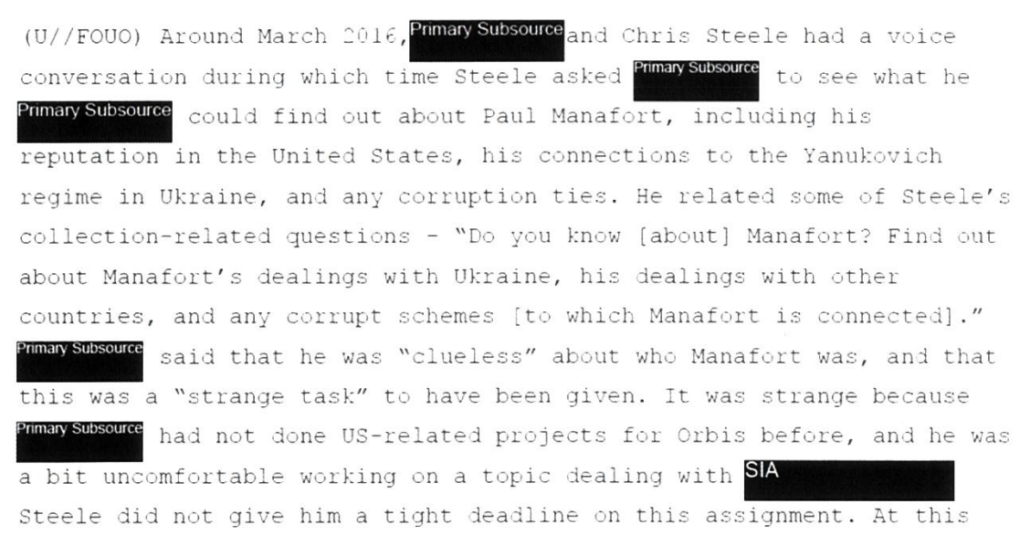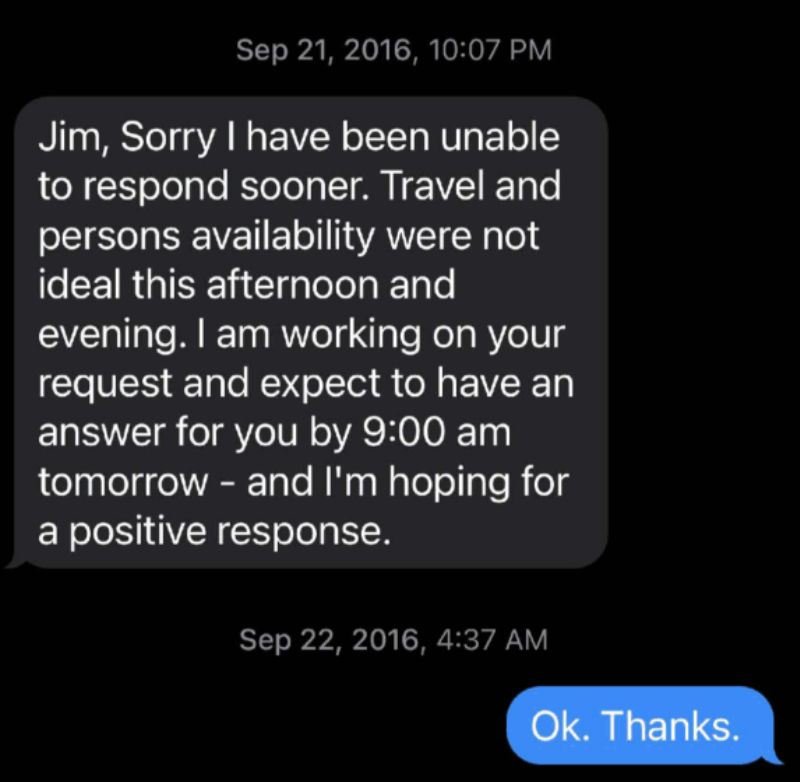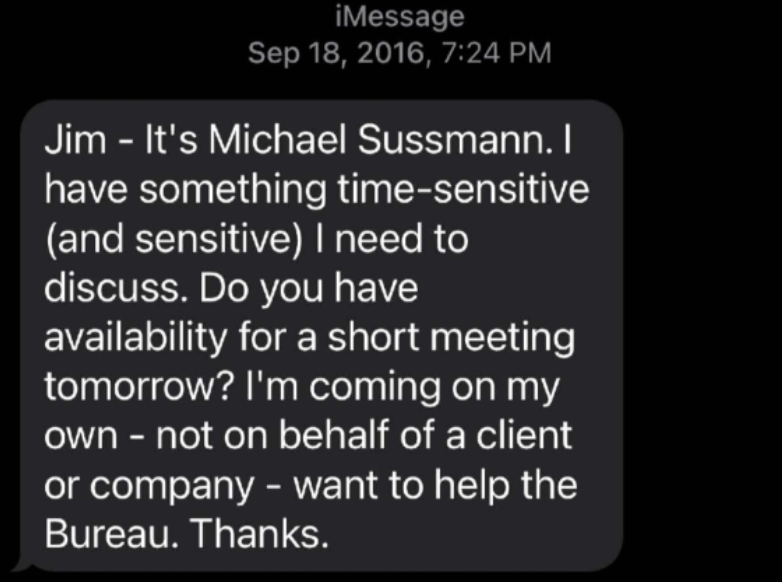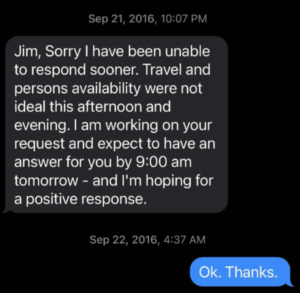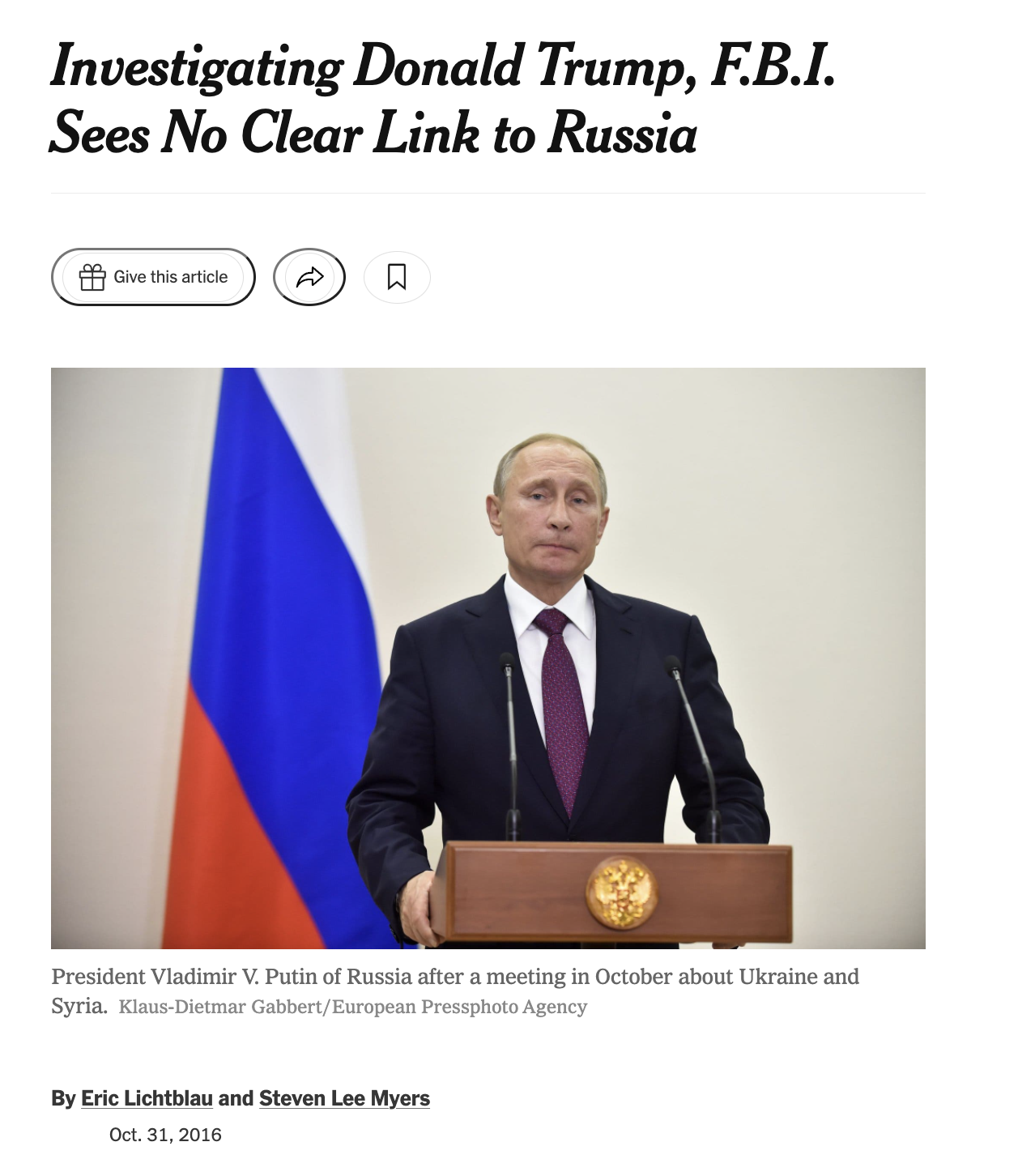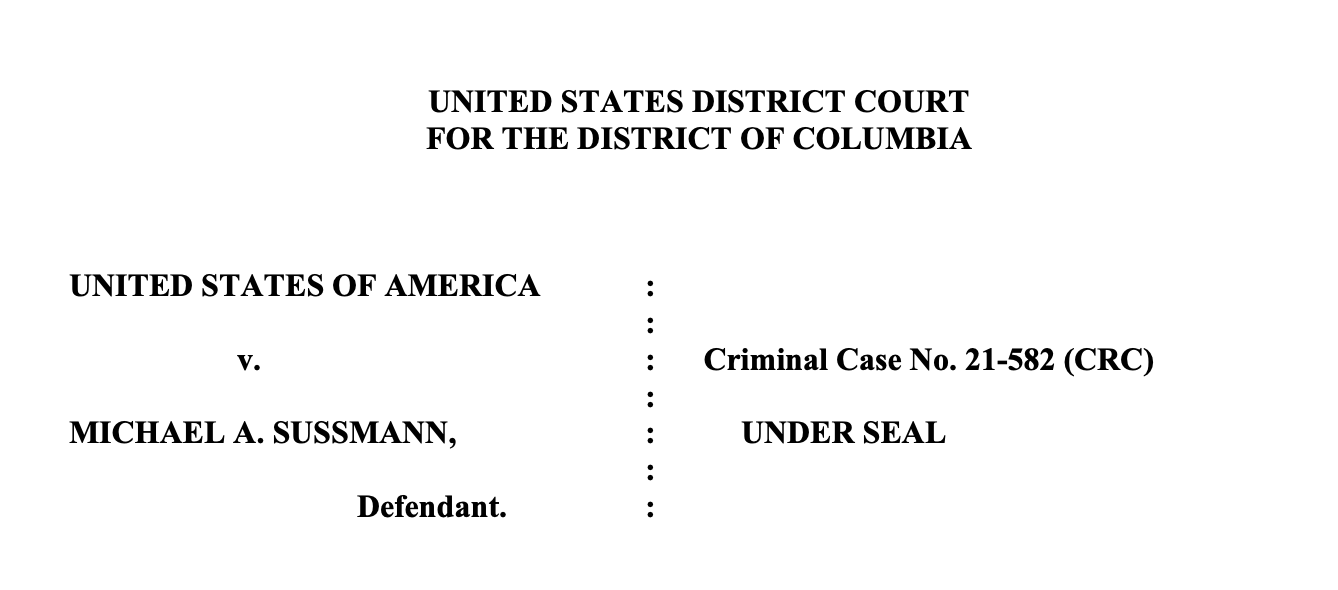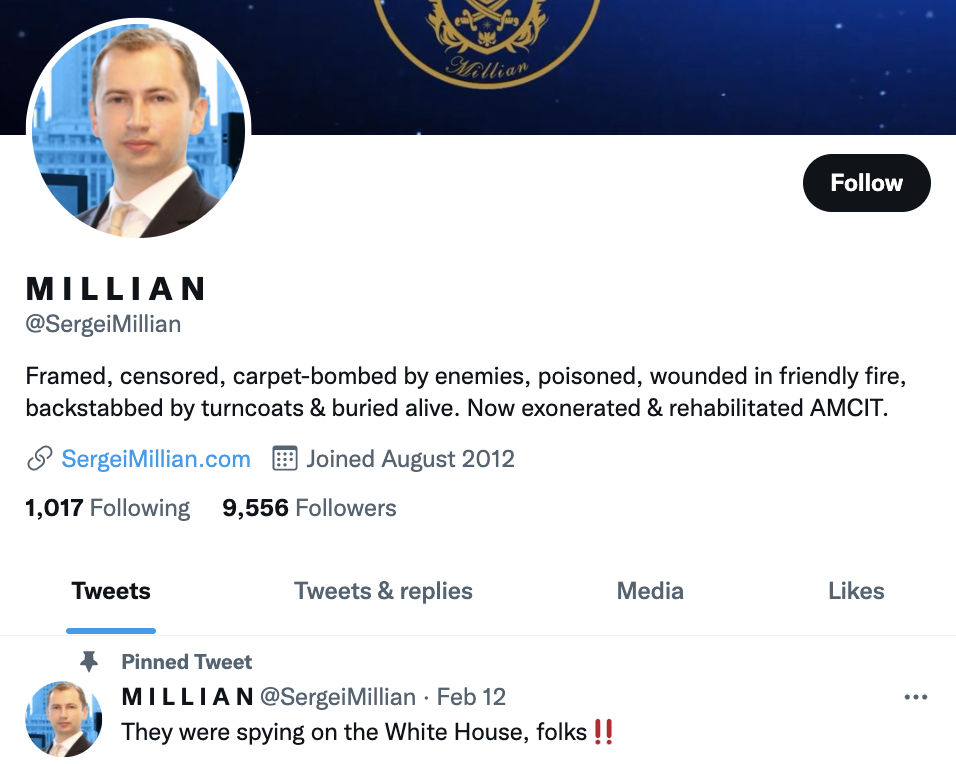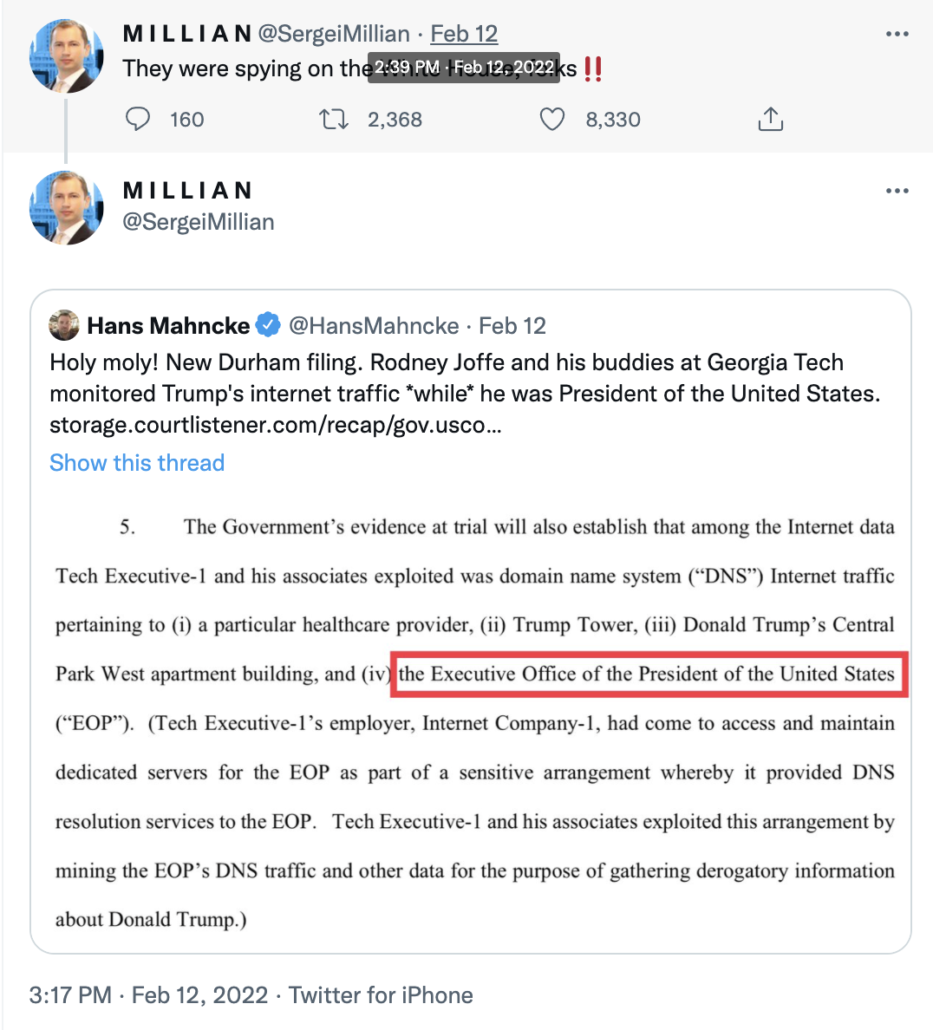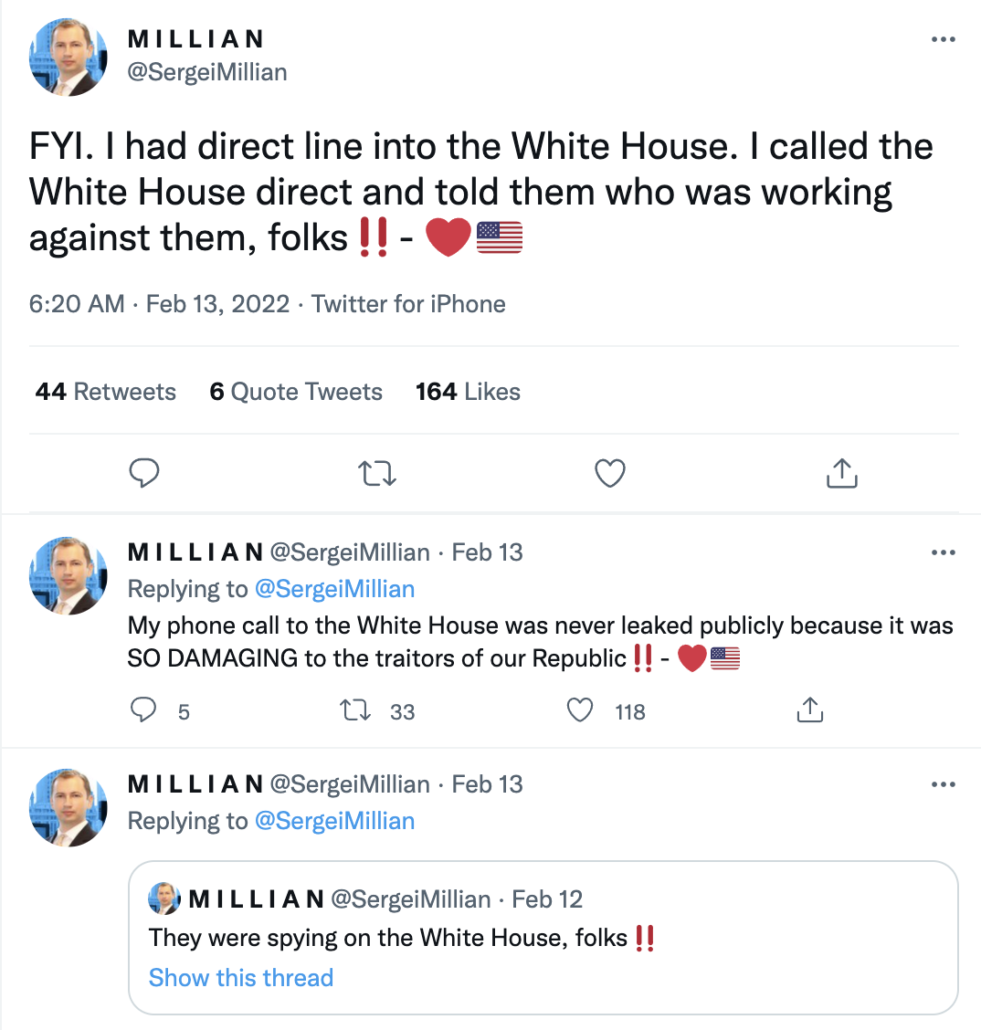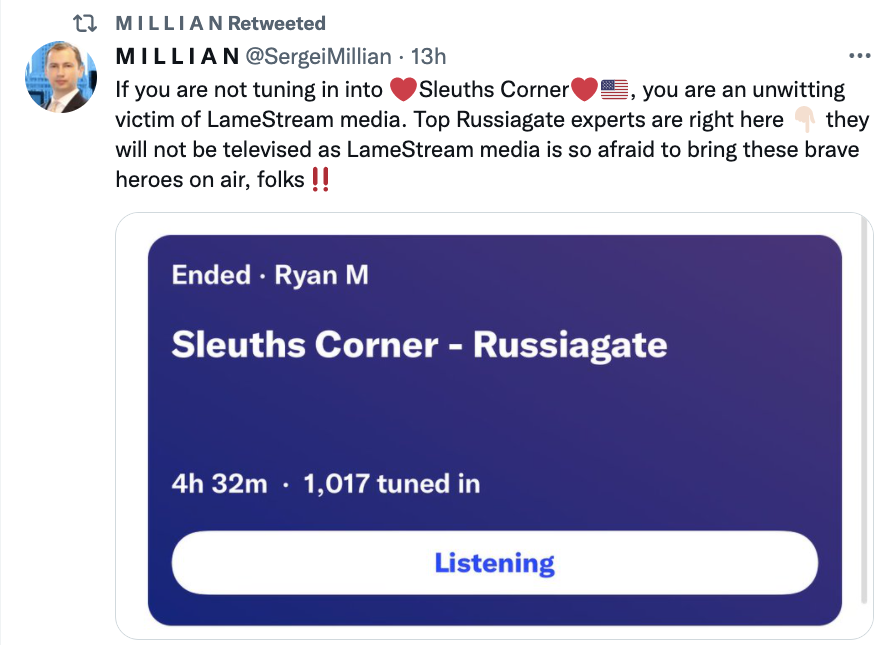John Durham Created a False Pee Tape Panic Based Off a “Literally True” Alleged Lie
Here’s how Judge Anthony Trenga explained his decision to dismiss the false statement charge against Igor Danchenko tied to Chuck Dolan, a charge alleging that Danchenko lied to his handling agent Kevin Helson when he responded to a question about whether he, “talked to Chuck Dolan about anything that showed up in the dossier,” with, “No. We talked about, you know, related issues, perhaps, but no, no, no, nothing specific.”
[A] prosecution for a false statement under Section 1001 cannot be based on a literally true statement even if that response is nonresponsive or misleading.
[snip]
The government presented two witnesses that provided direct evidence concerning Count 1: Charles Dolan and FBI Special Agent Kevin Helson. Dolan identified to one occasion when he spoke on the phone with Mr. Danchenko about the dossier, specifically on January 11, 2017, the day after it was published by BuzzFeed. Dolan testified, however, that there was no discussion about anything in the dossier, precisely what Danchenko told Helson, although the dossier was mentioned.
[snip]
Special Agent Helson confirmed in his testimony that he never explained to the defendant what he meant by “talked,” nor did he follow up with the defendant about what the defendant meant by his answer that he had talked about related issues with Dolan.
[snip]
The standard definition of “talk” means communication through the spoken word.
Applying that definition, the evidence in this case establishes that Mr. Danchenko’s answer was literally true.
[snip]
Helson asked an unambiguous question, defined otherwise would allow the government to impose the serious consequences of criminal liability under Section 1001 by divorcing words from the commonly understood meaning.
[snip]
Agent Helson testified that if what Dolan said was true, Mr. Danchenko’s answer was literally true; and in light of that testimony, Agent Helson understood the question the same way that Mr. Danchenko did, as asking for verbal communications.
Trenga’s decision came after the prosecution rested Friday, and Danchenko opted not to mount a defense (he was never going to do so; he never provided a witness list). On Monday, the two sides will present their closing arguments, and the jury will move to deliberating over the four remaining charges, which allege that Danchenko lied when he told the FBI, over and over, that he believed that an anonymous caller he claimed to have spoken to in late July 2016 was Sergei Millian. I hope to do a follow-up post explaining the evidence presented on those four charges.
Judge Trenga dismissed this charge because John Durham had accused Igor Danchenko of lying when all the evidence, including the affirmative testimony of two of Durham’s own witnesses, shows his statement was “literally true.”
Trenga judged that Durham had accused Danchenko of lying when in fact he was telling the truth after Durham, the frothers, and far too many members of the legacy press spent almost a year spinning conspiracy theories based on it, most notably by claiming that Chuck Dolan (whose ties to Democrats Durham and the press also wildly overstated) was the source for the pee tape allegation, even though Danchenko had named one of his Russian associates as the source and even though (we now know) Dolan claims he doesn’t remember meeting Danchenko at the Moscow Ritz, much less talking about pee tapes.
Trenga dismissed the charge after Durham spent much of the four day trial trying to bolster the materiality claims behind this charge.
For example, Durham prosecutor Michael Keilty had former FBI analyst Brittany Herzogg testify about how, months after the literally true alleged lie (Herzogg first joined the Mueller team the month after the literally true alleged lie), she tried but was not permitted to get the Mueller team to take further steps to investigate Dolan. Similarly, prosecutor Brittain Shaw had Special Agent Amy Anderson describe how at least three and possibly as many as six months after Danchenko told the literally true alleged lie, her supervisor on the Mueller team (which had to have new predications approved by Rod Rosenstein) did not let her open an investigation into Dolan.
On at least two occasions, these efforts to bolster the materiality of this literally true alleged lie extended to attempting to introduce false or misleading testimony to the jury.
On cross, Danny Onorato caught Shaw eliciting a false claim from Anderson — that Danchenko had not revealed Dolan’s ties to Dmitry Peskov — when in fact he had revealed that during the interview where he told the literally true alleged lie.
Q Okay. And are you aware that Mr. Danchenko in June, despite what Ms. Shaw asked you and despite what you told her, actually described that Mr. Dolan knew the press secretary of Vladimir Putin? Right?
A According to this document, yes.
Q Yeah. And it came from Mr. Danchenko, right?
A Yes.
Q Okay. And so you said that if you knew there was a connection back in June of Mr. Peskov and Mr. Dolan, that would be significant, right?
A Yes.
Q And you knew it in June, right?
A Yes.
Q And when you testified, you weren’t trying to lie; were you?
A I was absolutely not trying to lie.
Earlier that morning, Danchenko attorney Stuart Sears caught Durham himself trying to make further misrepresentations on this topic. In an attempt to suggest that Sears had coached Danchenko handler Kevin Helson to claim (falsely, Durham wanted to prove) that Danchenko had never been asked about the report at issue in this charge, Steele Report 105, Durham asked Helson to refer back to the original Danchenko interviews where — Durham falsely claimed — Helson would find Supervisory Analyst Brian Auten asking Danchenko about Report 105.
Q Now, counsel also asked you some questions on cross-examination yesterday that you — the question was asked and you kind of adopted it. The question was essentially — and Mr. Auten never asked Mr. Danchenko about the report number, which was 2016/105. It was the Manafort report.
A Okay.
Q He asked you if Auten asked him about that, and you said no or you adopted the question no. Do you recall, sir, whether or not — in the three-day interview in January of 2017 whether or not Mr. Danchenko was, in fact, asked questions and there was reporting in the report about the Manafort part of the dossier?
A I didn’t recall that, no.
Q All right. Do you recall it now? Well, let me withdraw that. I’d ask you to take a look at Government’s Exhibit 100. It’s just for identification in the record now. You are free, of course, to look at the entirety of it, but I would direct your attention most particularly to pages 11 and 12 to see if that refreshes your recollection as to whether or not Mr. Danchenko is, in fact, asked questions relating to Paul Manafort and the like in January 2017.
[snip]
A Is there a particular page?
Q Pages 11 and 12, but look through it as you want. Does that refresh your recollection, sir, as to whether, in fact, Mr. Danchenko had been asked about the Manafort matters back in January of 2017?
Here’s the passage of Danchenko’s January 2017 interviews where, Durham falsely claimed, Helson would find memorialization of Auten asking Danchenko about Report 105 — the report describing that Corey Lewandowski hated Manafort.
Not only does this passage relate to entirely different details about Manafort — his ties to Viktor Yanukovych rather than his animosity with Corey Lewandowski, not only does it address events that transpired even before Manafort started replacing Lewandowski as Trump’s Campaign Manager, not only do these events precede the report in question by five months, but this is not even a reference to what is known as the Steele dossier, paid for by Perkins Coie.
It’s a reference to the reporting on Manafort specifically that Oleg Deripaska paid for.
As Sears explained in a sidebar, Durham was deliberately conflating broader Manafort reporting (nobody pointed out what I have, that this specific reference wasn’t even to what is known as the Steele dossier) with the single report he charged.
MR. SEARS: Your Honor, Mr. Durham’s question has created the impression, I think, that the Manafort discussion, as referenced in that report, was about Report 105. My question was very specific about whether he had ever been shown that specific report. It is true that Paul Manafort came up during discussions.
THE COURT: In January?
MR. SEARS: In January. But just about his relationship with Ukraine, not about his resignation from the campaign or any of those issues. I’m concerned about the impression he’s giving to the jury because of the way the questions were asked. It is redirect.
THE COURT: On cross, he said that he wasn’t aware of —
MR. SEARS: Whether or not he had ever been shown that report.
THE COURT: So the report itself?
MR. SEARS: The report itself.
John Durham, in his attempt to prove that Danchenko lied about something that actually mattered in that literally true alleged lie, misrepresented the record, falsely claiming that Helson had misspoken.
I know! It’s dizzying even for me! And I knew this was a misrepresentation as soon as frothers falsely claimed Durham had caught Sears in a lie.
By yesterday’s testimony, Danchenko’s lawyers summarized what the Dolan charge was really about as opposed to what Durham had spun it into by mocking the idea you’d open an espionage investigation into someone because they repeated the publicly known fact that Corey Lewandowski hates Paul Manafort.
Q Okay. And I just want to ask one final question because I think you talked about Russian misinformation. Correct?
A Correct.
Q Do you think it could be Russian misinformation that Corey Lewandowski hated Paul Manafort back in July of 2016?
A I honestly don’t remember that specific allegation. Anything could be Russian misinformation.
Q Sure.
A It’s possible.
Q But I’m asking you. If you heard from me, “Corey Lewandowski hates Paul Manafort,” would you then run and open up an espionage investigation based on that fact?
A No.
The pushback from Durham’s prosecutors, discussing the the dossier in terms of “Russian interference,” “Russian-related,” and “related to Russia,” is actually a fair enough point.
Q And in terms of — he asked you about Mr. Manafort and Lewandowski. With respect to knowing whether someone passed false information that contained allegations — not the Lewandowski part but somebody made up that they were an insider or had inside information, in the course of looking at Russian interference, as you did in the Special Counsel’s investigation, would that have been important to you?
[snip]
Would it be relevant to you if that information actually had come from somebody the dossier claimed to be a Trump insider and the dossier was a Russian related — related to Russia and Donald Trump’s connections to Russia? Correct?
A Correct.
Q So would it have been relevant to know in that dossier that that information came from a Trump insider?
A Yes.
But that was an argument to investigate Dolan, not to prosecute Danchenko for his literally true statements about Dolan.
Taken on its face, too, it’s a vindication of opening an investigation to find out which of Trump’s Coffee Boys were lying about their role in a Russian influence operation. If this is your standard — and it is the standard Durham has finally adopted — then every investigation Crossfire Hurricane opened up was justified.
As I’ll show, Durham went further still yesterday, arguing that Mueller’s investigators hadn’t investigated Sergei Millian aggressively enough in 2017.
In any case, thus far, the only people who have been demonstrably lying are Durham’s own witnesses and, arguably, his own prosecution team. As Durham has been sustaining this claim that Danchenko lied even though what he said was literally true, Durham has burned two reportedly valuable FBI sources, damaged US cybersecurity efforts, partnered with a now-sanctioned Russian bank, and forced the declassification of details of multiple FBI counterintelligence investigations.
That is the damage Durham has wrought while he has been spinning tales of pee tapes to sustain his investigation.
At least with regards to Chuck Dolan, Judge Trenga has ruled, Igor Danchenko was literally telling the truth. Durham made of that literally true statement a bogus pee tape panic that has done breathtaking amounts of damage.
Update: Added more context per Frank Probst’s comment.


